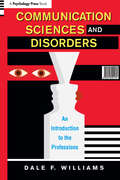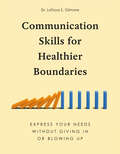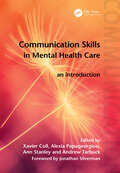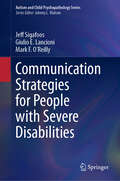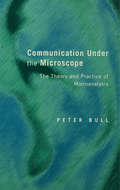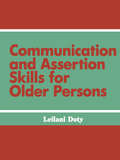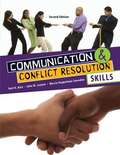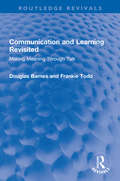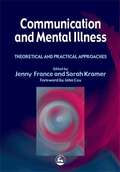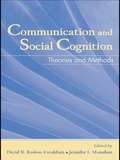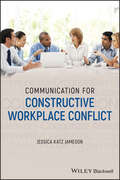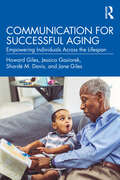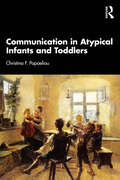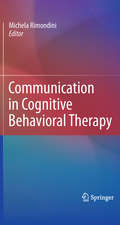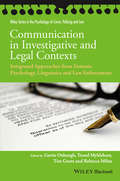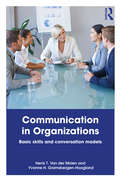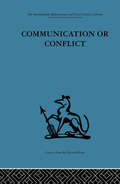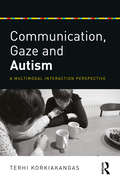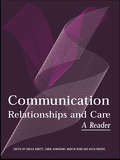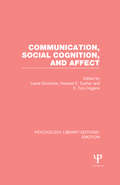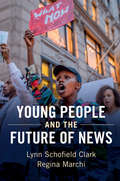- Table View
- List View
Communication Miracles for Couples: How to Fix a Broken Relationship for More Love and Less Conflict
by Jonathan RobinsonLearn How to Fix A Broken Relationship“The simplest, most practical and effective communication book for couples.” —Betty Eadie, author of Embraced by the Light and The Awakened Heart#1 Bestseller in Marriage & Family, Family Relationships, and DivorceCreate lasting harmony, healthy communication, and everlasting love with Jonathan Robinson's powerful couple communication book.Develop effective communication skills for a lasting relationship. The original Communication Miracles for Couples by bestselling author, psychotherapist, and one of Oprah's favorite relationship experts Jonathan Robinson has helped hundreds of thousands of couples repair their relationships with over 200,000 copies sold. Now updated, you can learn how to fix a broken relationship or simply strengthen your relationship using proven marriage therapy tools and techniques.Become one of those couples that work—period. This couple communication book is for couples who want to learn new skills and build a solid foundation for working through conflicts and moving forward in ways that strengthen their bonds. Learn how to enhance your relationship by learning to communicate with less blame and more understanding.Inside, you’ll find:Insightful tips to repair your marriageCouples communication skills to help you stop arguing, feel loved, and repair broken trust in your relationshipThe best at-home book for couples therapy, written by a trusted psychotherapistReaders of couple communication books like Relationship Goals, Alpha Female Bible, or More Love Less Conflict will love Communication Miracles for Couples.
Communication Sciences and Disorders: An Introduction to the Professions
by Dale F. WilliamsFew activities can match the complexity of human communication. Given its intricacy, it is understandable that the process will not always work properly. When it doesn't, the effects can be devastating, given how much of everyday life depends on communicating with one another. Despite its importance, however, much is still unclear about how we turn thoughts into language and then speech. Debates rage over various components of the communication system. Myths abound, most based on nothing more than speculation and misinformation. It all makes for a fascinating area of study and practice, particularly when considering the importance of the topic. This book provides readers with the basics of human communication without shying away from the controversies. Dale F. Williams, Ph.D. utilizes a panel of internationally recognized experts in all areas of the field to clearly explain normal communication as well as disorders of speech, language, hearing, and swallowing. Topics that overlap all disorders—diagnosis, treatment, research, ethics, work settings, and multicultural issues—are also covered in a reader-friendly style. In addition to the relevant information on human communication, the book also includes first-hand accounts of both people with disorders and those who work with them. Discussion questions are posed to help readers explore the gray areas and additional readings are described for those wishing to research specific topics. In these ways, readers are provided with information that truly helps them to understand communication sciences and disorders from a variety of perspectives. Communication Sciences and Disorders: An Introduction to the Professions is essential reading for anyone contemplating a career in speech-language pathology or audiology. In addition, the clear and entertaining writing style makes the field, in all its complexity, accessible to anyone with even a passing interest in the process of human communication.
Communication Skills for Healthier Boundaries: Express Your Needs without Giving In or Blowing Up
by Dr. LaToya S. GilmoreEstablish healthier boundaries with communication skills that everyone needsIn Communication Skills for Healthier Boundaries, Dr. LaToya S. Gilmore empowers you with the communication tools and strategies to build and maintain fulfilling relationships while honoring your own needs. Discover how to effectively express yourself, confidently say yes or no, and create the boundaries that support your well-being. Whether you&’re looking to strengthen, relax, or establish boundaries, this book provides practical guidance to help you thrive in every aspect of your life. Embrace the journey to healthier, happier connections!This book features: VERBAL AND NONVERBAL COMMUNICATION SKILLS & ACTIVITIES for building assertiveness, confidence, self-awareness, and moreCOMMON BOUNDARY ISSUES that are addressed and explored using the skills and tools needed to navigate these challengesREAL-LIFE SCRIPTS OF DIALOGUES to help readers practice asserting boundaries
Communication Skills in Mental Health Care: An Introduction
by Alexia Papageorgiou Xavier Coll Ann Stanley Andrew TarbuckCommunicating effectively when addressing psychiatric and psychological problems in everyday practice can be difficult. This book provides a clear and concise guide on how to run consultations, using the Calgary-Cambridge Model. The model is applied to an extensive variety of mental health conditions, ranging from taking a good psychiatric history to specialist scenarios such as working with families and young people or breaking bad news in mental health. There are also practical and comprehensive chapters on anxiety, depression, psychosis, risk to self, mental capacity, dealing with emotions and mental health consultations in primary care. An accompanying downloadable resource enhances knowledge and promotes greater understanding through a series of simulated consultations which explore and answer the OSCE questions posed in the text. The practical, accessible and comprehensive approach helps clinicians increase their confidence in mental health consultations. It is also of great benefit to students wishing to improve their clinical skills and ultimately to pass their exams.
Communication Strategies for People with Severe Disabilities (Autism and Child Psychopathology Series)
by Jeff Sigafoos Giulio E. Lancioni Mark F. O’ReillyThis book describes communication strategies for people with severe disabilities who are nonverbal or minimally verbal. It examines the major assessment and intervention strategies that have been developed to enable expressive and receptive communication. In addition, the book explores contemporary research focused on teaching nonverbal and minimally verbal persons to use a range of communication strategies for expressive and receptive communication. It addresses the advantages and disadvantages of each communication strategy, selecting curriculum for communication intervention programs, and assessing the communication needs of individuals with severe disabilities who are nonverbal or minimally verbal. Key areas of coverage include: Assessing communication strengths and areas of intervention need. Developing communication intervention curricula. Prelinguistic intervention. Natural gestures and manual signing strategies. Aided augmentative and alternative communication strategies, including tangible symbols, picture-based systems, speech-generating devices, and assistive technology solutions for individuals with sensory-motor impairment. Visual strategies to enhance receptive communication. Communication Strategies for People with Severe Disabilities is an invaluable resource for clinicians, therapists, and other professionals as well as researchers, professors, and graduate students in the interrelated fields of clinical child and school psychology, developmental psychology, child and adolescent psychiatry, clinical social work, applied behavior analysis, augmentative and alternative communication, special education, and speech-language pathology.
Communication Under the Microscope: The Theory and Practice of Microanalysis
by Peter BullSocial interaction in recent years has become the focus of systematic scientific research in a wide variety of academic disciplines. In Communication under the Microscope, Peter Bull shows how communication has become an object of study in its own right, which can be dissected in the finest detail through the use of film and recording technology. In so doing he provides a clear and valuable introduction into the theory and practice of microanalysis.Bull argues that microanalysis is both a distinctive methodology and a distinctive way of thinking about communication. He then focuses on the two principal elements of face-to-face communication: speech and non-verbal behaviour. Communication in particular social contexts is also addressed with related chapters on gender and politics. Finally, the practical aspects of microanalysis are discussed.This unique and thorough review of microanalysis integrates different approaches and draws together research literature which is often diverse and disparate. Presented in a clear and focused style, this book will be of interest to psychologists, social scientists and all students and researchers in the field of communication.Communication is central to many aspects of human life, yet it has only recently become the focus of systematic scientific investigation within a wide variety of academic disciplines. Communication has now become an object of study in its own right, and can be dissected in the finest detail with the use of recording technology (film, audiotape and videotape). This approach has become known as 'microanalysis', and forms the principal theme of Communication under the Microscope.
Communication and Assertion Skills for Older Persons (Death Education, Aging and Health Care)
by Leilani DotyFirst published in 1987. Routledge is an imprint of Taylor & Francis, an informa company.
Communication and Community Engagement in Disease Outbreaks: Dealing with Rights, Culture, Complexity and Context
by Rafael Obregon Erma Manoncourt Ketan ChitnisThis book provides readers with a critical, conceptual and applied understanding of the role of communication and community engagement for disease outbreak preparedness and response.Until the WHO declared COVID-19 a pandemic on March 11, 2020, for several years public health authorities and influential voices in the international public health community have warned of a pandemic and therefore a need to strengthen governments and communities’ ability to prevent and respond to it effectively to minimize its impact on lives and economies. While investments have focused on clinical, diagnostic, and vaccine research, preventing and minimizing the impact of disease outbreaks requires a wider socio-ecological systems approach that places communities at the centre of the response. Such an approach is still rare in public health practice. One of the key lessons that the authors have learned, and on which they reflect in the chapters, is that technical inputs will be as effective as they are fully integrated within the broader architecture of disease outbreak preparedness and response. The ten chapters of this contributed volume are organized under three parts: a conceptual framework, case studies, and recommendations. Communication and Community Engagement in Disease Outbreaks is a timely and essential resource for public health managers, donors, implementers, organizations engaged in disease prevention and control and academics called on to support the response. These audiences should benefit from this approach as the book highlights dimensions that are often under-resourced.
Communication and Conflict Resolution Skills
by Neil H. Katz John W. Lawyer Marcia SweedlerCommunication And Conflict Resolution Skills by Neil H. Katz, John W. Lawyer, and Marcia K. Sweedler
Communication and Learning Revisited: Making Meaning Through Talk (Routledge Revivals)
by Frankie Todd Douglas BarnesFirst published in 1995, Communication and Learning Revisited focuses on the importance and benefits of group dialogue in cooperative learning. The book explores the use of group dialogue among students across a variety of disciplines and demonstrates how collaboration helps them to understand different concepts. It outlines cognitive and social strategies that can enhance collaboration and presents collaborative talk’s role in learning, setting forth a theoretical framework that draws upon the ideas of writers such as Vygotsky and Bakhtin. Communication and Learning Revisited will appeal to those with an interest in teaching methods, classroom dialogue, and cooperative learning.
Communication and Mental Illness: Theoretical and Practical Approaches
by Sarah Kramer John Cox Jenny FranceCommunication and Mental Illness is a comprehensive and practical textbook written by a multidisciplinary group of experts in the field of mental health which will be of interest to all those interested in improving their understanding of individuals with mental illness. The book is divided into three parts. The first of these offers both student and experienced clinicians in the mental health field an improved theoretical knowledge of the methods of communication commonly adopted by individuals with a variety of diagnoses of mental illness. It also provides practical suggestions of how this information can improve the individual professional's management of patients. Part Two looks at how information about communication in mental illness can influence service provision, ending with suggestions for future policy and practice. Communication and Mental Illness concludes with a final part describing the state of current research into different facets of communication and mental illness, offering an insight into the variety of research methodology and points of interest to those involved in the field.
Communication and Social Cognition: Theories and Methods (Routledge Communication Series)
by David R. Roskos-Ewoldsen Jennifer L. MonahanCommunication and Social Cognition represents the explosion of work in the field of social cognition over the past 25 years. Expanding the contribution made by Social Cognition and Communication, published in 1982, this scholarly collection updates the study of communication from a social cognitive perspective, with contributions from well-known experts and promising new scholars in diverse areas of communication. Organized into sections--message production, interpersonal communication, media, and social influence--the collection reflects the areas in which social cognition theories have become integral in understanding communicative processes, and in which a proliferation of scholarship has emerged. Readers are informed of the current major trends in social cognition research, and are introduced to its history. Throughout the text, chapter authors highlight both theoretical and methodological aspects of research, encouraging communication scholars to include social cognition in their research, and, likewise, promoting communication to social cognition researchers. The volume addresses the future of social cognition, including the most fitting directions in which to take scholarship, emerging theories in the field, and the methods currently yielding the most promising results. Communication and Social Cognition appeals to scholars, researchers, and advanced students in communication and psychology. It can be used as a textbook in graduate courses related to social cognition, social influence, message production, interpersonal communication, media effects, and message design.
Communication as Comfort: Multiple Voices in Palliative Care (Routledge Communication Series)
by Sandra L. Ragan Elaine M. Wittenberg-Lyles Joy Goldsmith Sandra Sanchez ReillyThis exceptional work explores the complexities of communication at one of the most critical stages of the life experience--during advanced, serious illness and at the end of life. Challenging the predominantly biomedical model that informs much communication between seriously ill and/or dying patients and their physicians, caregivers, and families, Sandra L. Ragan, Elaine M. Wittenberg-Lyles, Joy Goldsmith, and Sandra Sanchez-Reilly pose palliative care--medical care designed to comfort rather than to cure patients--as an antidote to the experience of most Americans at the most vulnerable juncture of their lives. With an author team comprised of three health communication scholars and one physician certified in geriatrics and palliative medicine, this volume integrates the medical literature on palliative care with that of health communication researchers who advocate a biopsychosocial approach to health care. Applying communication theories and insights to illuminate problems and to explain their complexities, the authors advocate a patient-centered approach to care that recognizes and seeks to lessen patients’ suffering and the many types of pain they may experience (physical, psychological, social, and spiritual) during life-threatening illness.
Communication for Constructive Workplace Conflict
by Jessica Katz JamesonA unique textbook for students or professionals across a range of disciplines offering a novel approach to conflict communication Communication for Constructive Workplace Conflict describes how daily human behavior and communication can contribute to collaborative conflict management in any organization. Using the LEARN (Listening, Engaging, Acknowledging, Rapport, and Nurturing) communication framework, this practical textbook explains, analyzes, and critiques a range of individual responses to workplace friction, offers evidence-based communication strategies for effectively managing conflicts, and promotes a philosophy that builds an environment that invites active participation rather than avoidance and silence. Designed for courses teaching organizational communication and conflict management, Communication for Constructive Workplace Conflict draws directly from the author’s 25 years of experience performing conflict research in numerous corporations, hospitals, public agencies, multi-sector laboratories, and non-profit organizations. Following the intuitive LEARN model, readers are provided with the theoretical and empirical support for managing conflicts as they emerge and creating an environment for more productive conflict in real-world scenarios. Throughout the text, concise and accessible chapters integrate key literature from disciplines including Communication, Management and Negotiation, Political Science, Psychology, and Public Administration to illustrate the impact the larger organizational context has on communication, conflict, and the social environment within organizations. Offers practical implications for communication in daily activities in ways that support trust-building and positive relationships Presents a framework based on the Communication as Constitutive of Organization (CCO) model, Contains theoretical and research-based explanations and diverse case studies to provide practical guidance for organizational members at all levels Reinforces the LEARN model with engaging, class-tested activities that allow students to practice constructive conflict communication Examines the impact of societal trends and how each individual’s communication either promotes or impedes collaboration and constructive conflict interactionFeaturing timely discussion of the impact of social distancing due to the COVID-19 pandemic and the roles of social media and online dispute resolution, Communication for Constructive Workplace Conflict is an excellent textbook for upper-level undergraduate and graduate students new to the field of conflict studies or organizational communication, a valuable supplement for students of management, organizational psychology, and public administration, and a useful reference for professional mediators, consultants, trainers, and managers.
Communication for Successful Aging: Empowering Individuals Across the Lifespan
by Jessica Gasiorek Howard Giles Shardé M. Davis Jane GilesThis essential volume explores the vital role of communication in the aging process and how this varies for different social groups and cultural communities. It reveals how communication can empower people in the process of aging, and that how we communicate about age is critically important to – and is at the heart of – aging successfully.Giles et al. confront the uncertainty and negativity surrounding "aging" – a process with which we all have to cope – by expertly placing communication at the core of the process. They address the need to avoid negative language, discuss the lifespan as an evolving adventure, and introduce a new theory of successful aging – the communication ecology model of successful aging (CEMSA). They explore the research on key topics including: age stereotypes, age identities, and messages of ageism; the role of culture, gender, ethnicity, and being a member of marginalized groups; the ingredients of intergenerational communication; depiction of aging and youth in the media; and how and why talk about death and dying can be instrumental in promoting control over life’s demands. Communication for Successful Aging is essential reading for graduate students of psychology, human development, gerontology, and communication, scholars in the social sciences, and all of us concerned with this complex academic and highly personal topic.
Communication in Atypical Infants and Toddlers
by Christina F. PapaeliouThis book presents a comparative review of the latest studies and data on prelinguistic communication and early semantic development in autism spectrum disorder (ASD), Williams syndrome (WMS), attention-deficit/hyperactivity disorder (ADHD), and early language delay. Papaeliou offers a critical analysis of the literature, compares key theoretical approaches, and interprets data on development in atypical populations.A fruitful synthesis of theory and research reveals that, instead of cognitive deficits, the core feature of these neurodevelopmental disorders consists of deficits in the ability for self- and intersubjective coordination, which adversely affects early interactions and, consequently, the emergence of language. The book composes fragmentary proposals on the role of rhythm disruptions in different conditions, setting out the idea that disruption in interactional synchrony is a connecting thread through neurodevelopmental disorders which show high prevalence or high comorbidity rates. Papaeliou identifies distinct communicative patterns characteristic of each disorder and puts forward a unifying theory for interpreting data on early communication and language development in atypical populations.This is ideal reading for psychologists, psycholinguists, psychiatrists, paediatricians, speech therapists, and special educators. Students in developmental psychology and anyone interested in understanding the research behind typical and atypical development will also benefit from this text.
Communication in Cognitive Behavioral Therapy
by Michela RimondiniResearch has shown that the therapeutic alliance is a key factor in the success of treatment, and a critical component of establishing this alliance is the communication between therapist and client. The efficacy of treatment depends on the therapist's ability to collect reliable client information and create the foundation for a good relationship that involves the client in the healing process. Communication in Cognitive Behavioral Therapy provides an overview of the research and theory underlying the importance of therapeutic communication with a specific focus on cognitive behavioral psychotherapy. It brings together an international group of experts from the relevant disciplines of communication, psychotherapy, research and teaching to create an integrated perspective of this crucial area. The book offers a review of the main evidence-based theories, and is highlighted with specific examples and flow charts.Insight for trainers is given by providing learner-centered teaching methods that enhance the acquisition of these communication skills. For researchers, it offers both qualitative and quantitative analyses of the subject as well as a comprehensive review of the main analysis methods adopted in the field.
Communication in Investigative and Legal Contexts
by Tim Grant Rebecca Milne Gavin Oxburgh Trond MyklebustCommunication in Forensic Contexts provides in-depth coverage of the complex area of communication in forensic situations. Drawing on expertise from forensic psychology, linguistics and law enforcement worldwide, the text bridges the gap between these fields in a definitive guide to best practice. Offers best practice for understanding and improving communication in forensic contexts, including interviewing of victims, witnesses and suspects, discourse in courtrooms, and discourse via interpreters Bridges the knowledge gaps between forensic psychology, forensic linguistics and law enforcement, with chapters written by teams bringing together expertise from each field Published in collaboration with the International Investigative Interviewing Research Group, dedicated to furthering evidence-based practice and practice-based research amongst researchers and practitioners International, cross-disciplinary team includes contributors from North America, Europe and Asia Pacific, and from psychology, linguistics and forensic practice
Communication in Organizations: Basic Skills and Conversation Models
by Henk T. Van der Molen Yvonne Gramsbergen-HooglandOne of the most important requirements of leadership is effective communication. The idea that some people are natural leaders and that others will never learn to show good leadership is now outdated. It has been replaced by the conviction that leadership and communication skills can be learnt. This second edition of Communication in Organizations continues to give clear advice and guidance on communicating in a range of different contexts in the workplace. From handling complaints and breaking bad news to negotiating deals and giving presentations, it explores the building blocks to effective communication skills, nurturing the leadership qualities required in any organization. By defining the abstract concepts of ‘organization’ and ‘communication’, it provides readers with the necessary skills to conduct any conversation on a professional manner. Illustrated with concrete examples throughout, this new edition includes a new chapter on career coaching, with exercises and ideas for role-play to enable the ideas to come alive. The three parts work seamlessly to expand the readers’ conversation skill-set as they progress through the book. Communication in Organizations is an invaluable resource for students of management and business psychology, as well as those taking courses who are already in the workplace. The practical aspects compliment both introductory and advanced courses in interpersonal communication, leadership and business and professional communication.
Communication or Conflict: Conferences: their nature, dynamics, and planning
by Mary Capes A T M WilsonTavistock Press was established as a co-operative venture between the Tavistock Institute and Routledge & Kegan Paul (RKP) in the 1950s to produce a series of major contributions across the social sciences. This volume is part of a 2001 reissue of a selection of those important works which have since gone out of print, or are difficult to locate. Published by Routledge, 112 volumes in total are being brought together under the name The International Behavioural and Social Sciences Library: Classics from the Tavistock Press. Reproduced here in facsimile, this volume was originally published in 1960 and is available individually. The collection is also available in a number of themed mini-sets of between 5 and 13 volumes, or as a complete collection.
Communication, Conflict, and the Management of Difference
by Stephen W. Littlejohn Kathy Domenici"Littlejohn and Domenici provide the foundation for a thoughtful dialogue about human difference, conflict, and communication. Readers gain insight into why conflict occurs, how to analyze specific conflicts and strategies for mapping an effective approach. Drawing on numerous examples from their work in mediation, the authors discuss a variety of practical tools, models, and theories for managing differences. Effectively managing differences allows conflict, in whatever context, to become a positive resource rather than a barrier. "--BOOK JACKET.
Communication, Gaze and Autism: A Multimodal Interaction Perspective
by Terhi KorkiakangasIn this innovative book on autism and gaze from a multimodal interaction perspective, Terhi Korkiakangas examines the role of gaze in everyday situations, asking why eye contact matters, and considering the implications of this crucial question for autism. Since persons on the autism spectrum tend to use it differently and might not engage in eye contact in social situations, gaze is a crucial topic for understanding autism, yet we know surprisingly little about this topic in a real-world context, beyond psychological experiments and the research lab. Drawing on her research on authentic video-recorded social interactions, Korkiakangas shows how a multimodal interaction perspective can shed new light on gaze: what an instance of gaze does, and when, why, and for whom gaze ‘matters’, from both children on the autism spectrum and their social partners’ perspective, including teachers and parents. Grounded in the interactional tradition of conversation analysis, the multimodal interaction perspective offers a major contribution to our understanding of autism by examining communication beyond talk and linguistic resources. Communication, Gaze and Autism considers both mutual gaze and gaze aversion during talk or silence, alongside facial expressions, gestures, and other body movements, to understand what gaze is used for, and to rethink ‘eye contact’. The book includes a methodological introduction, practical tools for doing multimodal interaction research, and empirical findings. It also considers the voices of those people on the autism spectrum from the blogosphere, who suggest that eye contact has less significance for them and represents a communication difference, rather than a deficit. This book is designed for anyone with an academic, professional or personal interest in autism. It will particularly appeal to senior undergraduate and graduate students, researchers and practitioners in the fields of communication, social interaction and autism.
Communication, Relationships and Care: A Reader
by Carol Komaromy Martin Robb Sheila Barrett Anita Rogers<p>Communication and relationships have become an increasing focus of attention in debates about the future of health and social care. People working in care services are being encouraged to improve communication processes, to develop more participatory relationships with service users, and to work more closely in partnership with other professionals. <p>This Reader provides a comprehensive collection of literature that aims to enable those involved in care services, as workers, carers or service users, to reflect on their everyday interactions and to situate them in wider contexts. Including new material from the frontline of research and practice, as well as some classic readings, this wide-ranging volume emphasises the need to see interpersonal communication as embedded in relationships, and to take account of issues of power and diversity, as well as the emotional dimension of care work. Covering both health and social care, the Reader is divided into four sections, focusing on:* concepts and contexts* analysing aspects of communication* the person in the process* communication and relationships in organisations. <p>Communication, Relationships and Care will be an essential resource for students of social work, nursing, health and social policy, and for all involved in health and social care services, whether as professionals, carers or service users. It is a set book for the Open University's second level undergraduate course Communication and Relationships in Health and Social Care (K205).
Communication, Social Cognition, and Affect (Psychology Library Editions: Emotion)
by E. Tory Higgins Lewis Donohew Howard E. SypherOriginally published in 1988, the purpose of this book was to explore the interrelations among communication, social cognition and affect. The contributors, selected by the editors, were some of the best known in their fields and they significantly added to the knowledge of this interdisciplinary domain at the time. In late April 1986 the authors met at a conference centre at the University of Kentucky. They presented first drafts of their chapters and exchanged ideas. Out of these interactions came this book, which has a broad interest across several areas of psychology and communication. While answering a number of questions, the authors also posed others for future examination.
Communication, Society and Politics: Social Media and the Rise of Connective Journalism (Communication, Society and Politics)
by Lynn Schofield ClarkYoung People and the Future of News traces the practices that are evolving as young people come to see news increasingly as something shared via social networks and social media rather than produced and circulated solely by professional news organizations. The book introduces the concept of connective journalism, clarifying the role of creating and sharing stories online as a key precursor to collective and connective political action. At the center of the story are high school students from low-income minority and immigrant communities who often feel underserved or misrepresented by mainstream media but express a strong interest in politics and their communities. Drawing on in-depth field work in three major urban areas over the course of ten years, Young People and the Future of News sheds light on how young people share news that they think others should know about, express solidarity, and bring into being new publics and counter-publics.

